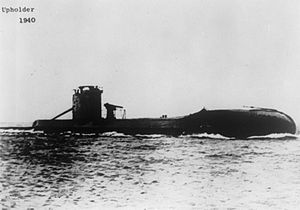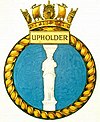HMS Upholder (P37)

HMS Upholder
|
|
| History | |
|---|---|
| Name: | HMS Upholder |
| Builder: | Vickers Armstrong, Barrow-in-Furness |
| Laid down: | 30 October 1939 |
| Launched: | 8 July 1940 |
| Commissioned: | 31 October 1940 |
| Identification: | Pennant number: P37 |
| Fate: | sunk 14 April 1942 |
| Badge: |  |
| General characteristics | |
| Displacement: |
|
| Length: | 191 ft (58.22 m) |
| Beam: | 16 ft 1 in (4.90 m) |
| Draught: | 15 ft 2 in (4.62 m) |
| Propulsion: | |
| Speed: |
|
| Complement: | 27–31 |
| Armament: |
|
HMS Upholder (P37) was a Royal Navy U-class submarine built by Vickers-Armstrong at Barrow-in-Furness. She was laid down on 30 October 1939, launched on 8 July 1940 by Mrs. Doris Thompson, wife of a director of the builders. The submarine was commissioned on 31 October 1940. She was one of four U-class submarines which had two external torpedo tubes at the bows in addition to the 4 internal ones fitted to all boats. They were excluded from the other boats because they interfered with depth-keeping at periscope depth.
She was commanded for her entire career by Lieutenant-Commander Malcolm David Wanklyn, and became the most successful British submarine of the Second World War. After a working up period, she left for Malta on 10 December 1940 and was attached to the 10th Submarine Flotilla based there. She completed 24 patrols, sinking 93,031 tons of enemy shipping including the Maestrale-class destroyer Libeccio after the Battle of the Duisburg Convoy, two submarines (the Tricheco and the Saint Bon), three troopships, six cargo ships, an auxiliary ship and an auxiliary minesweeper. Wanklyn was awarded the Victoria Cross for a patrol in her in 1941, which included an attack on a particularly well-defended convoy on 24 May 1941 in which Upholder sank the 17,879 GRT Italian troop ship SS Conte Rosso. On 28 July 1941 she damaged the Italian cruiser Giuseppe Garibaldi. On 18 September 1941 she sank two troopships within hours of each other: the sister ships MS Neptunia (19,475 GRT) and MS Oceania (19,507 GRT).
...
Wikipedia
